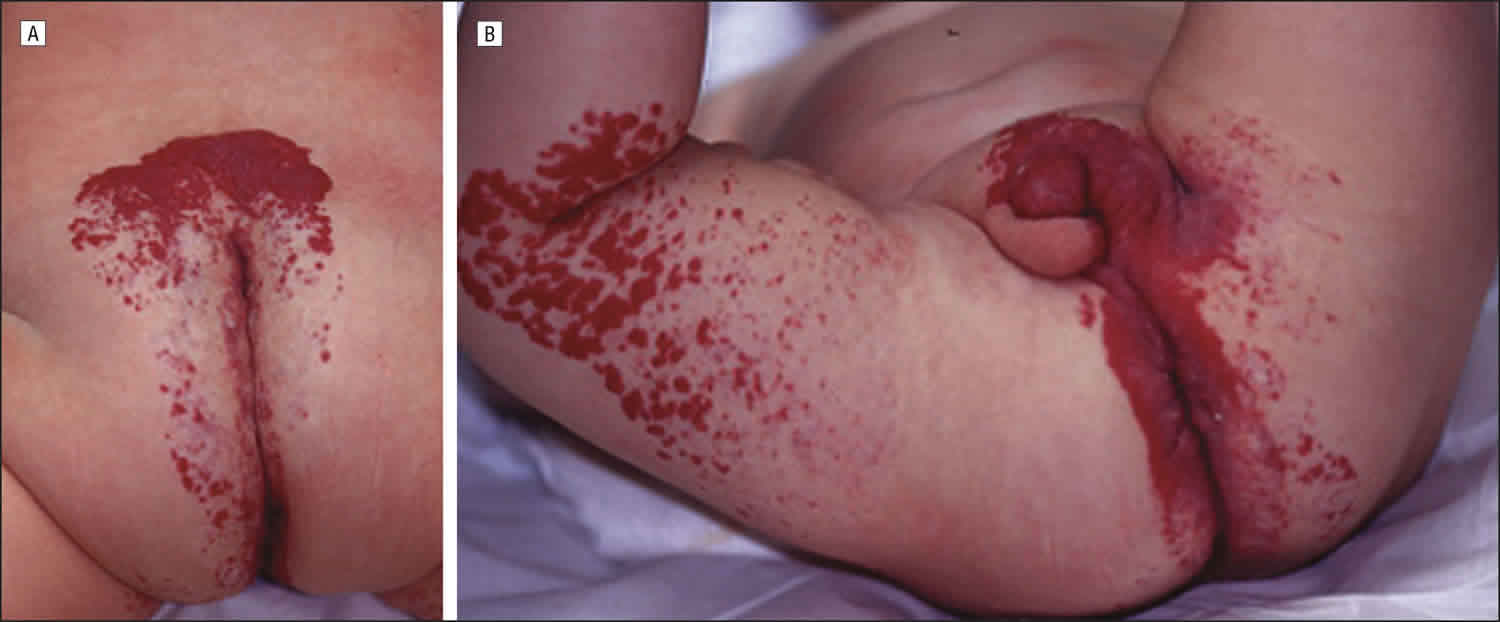Pelvis syndrome
PELVIS syndrome is an acronym for Perineal hemangioma, External genitalia malformations, Lipomyelomeningocele, Vesicorenal abnormalities, Imperforate anus, and Skin tag 1. The acronym PELVIS was proposed in 2006 by Dr. Celine Girard and colleagues 1. PELVIS syndrome is a an association between segmental infantile hemangiomas of the perineum (around the genitals and anus) and congenital anomalies involving the genitalia, urinary tract, spine, anus, and rectum. 45.5% of their patients showed the presence of a ‘skin tag’. They have also mentioned urorectal septum malformation sequence which could be partial or complete and is very similar to the constellation of signs described by them. Girard and colleagues explain that associated hemangiomas may not have been described in previous studies due to a patient recruitment bias in the dermatology and plastic surgery departments. Girard and colleagues propose that the association of hemangiomas could be a variant of the urorectal malformation sequence 2.
Another group has recently proposed the acronym LUMBAR to describe a collection of similar signs where the hallmark feature is a segmental lumbosacral haemangioma over the middle of the lower back 3.
- Lower body hemangioma and other cutaneous defects
- Urogenital anomalies, ulceration
- Myelopathy
- Bony deformities
- Anorectal malformations, arterial anomalies
- Renal anomalies
It is also felt by some that the two separately described LUMBAR and PELVIS syndrome may be the same due to the major overlap that is seen in the constellation of signs present 4.
Furthermore, there are similarities between LUMBAR and PELVIS syndromes and PHACE syndrome, which may suggest they are regional variations of the same pathological process.
PHACE syndrome is the association of a large hemangioma, usually on the face or neck, in combination with one or more other birth defects 5. People with PHACE syndrome may have Posterior fossa brain malformations, Hemangioma, Arterial lesions (blood vessel abnormalities in the head or neck), Cardiac (heart) abnormalities/aortic coarctation, and Eye abnormalities 5. Symptoms and symptom severity may vary from person to person. The cause of PHACE syndrome is currently unknown. It affects girls much more often than boys. Treatment is based on the signs and symptoms present in the person 5.
Figure 1. Perineal hemangioma
Footnote: (A) Massive hemangioma located from the sacral area to the posterior mid thighs, including the buttocks and the perineum, associated with an ulcerated area adjacent to the anus. (B) Perineal hemangioma with severe malformation of the external genitalia.
[Source 1 ]PELVIS syndrome diagnosis
Currently, there are no standardized diagnostic criteria or consensus on the collection of signs required to make a diagnosis of PELVIS syndrome. However, the presence of a segmental hemangioma over the perineum and/or lower back should lead to a search for associated congenital anomalies.
Investigations may include:
- Magnetic resonance imaging (MRI) of the spine to look for congenital spinal dysraphism.
- Ultrasonography can be used in young infants if there is no ulceration, neurological problem or sinus tracts.
- Imaging of the pelvis and perineum to detect deeper hemangiomas and underlying abnormalities of the kidney, urinary tract and genitalia.
PELVIS syndrome treatment
Each child has a unique clinical presentation and will require individual treatment. Medical care of the infant will be undertaken by a multidisciplinary team that may include plastic surgeon, pediatric urologist, pediatric dermatologist, radiologist, neurosurgeon, and neurologist.
- Treatment for the hemangioma may involve oral propranolol, systemic steroids, surgery and/or laser therapy.
- Surgery for the correction of the associated malformations (such as lipomyelomeningocoeles, vesicorenal abnormalities, external genital malformations) may be indicated.
- Girard C, Bigorre M, Guillot B, Bessis D. PELVIS Syndrome. Arch Dermatol. 2006;142(7):884–888. doi:10.1001/archderm.142.7.884
- Wheeler PG, Weaver DD. Partial urorectal septum malformation sequence: A report of 25 cases. Am J Med Genet. 2001;103:99–105.
- Iacobas I, Burrows PE, Frieden IJ, Liang MG, Mulliken JB, Mancini AJ, Kramer D, Paller AS, Silverman R, Wagner AM, Metry DW. LUMBAR: association between cutaneous infantile hemangiomas of the lower body and regional congenital anomalies. J Pediatr. 2010 Nov;157(5):795-801.e1-7. doi: 10.1016/j.jpeds.2010.05.027 https://doi.org/10.1016/j.jpeds.2010.05.027
- Frade F, Kadlub N, Soupre V, Cassier S, Audry G, Vazquez MP, Picard A. Du PELVIS au LUMBAR syndrome : à propos de 2 cas [PELVIS or LUMBAR syndrome: the same entity. Two case reports]. Arch Pediatr. 2012 Jan;19(1):55-8. French. https://doi.org/10.1016/j.arcped.2011.10.004
- PHACE syndrome. https://childrenswi.org/medical-care/birthmarks-and-vascular-anomalies-center/conditions/phace-syndrome





